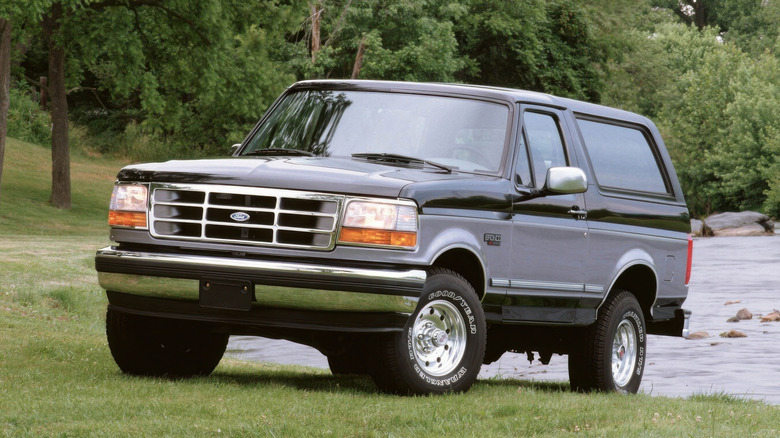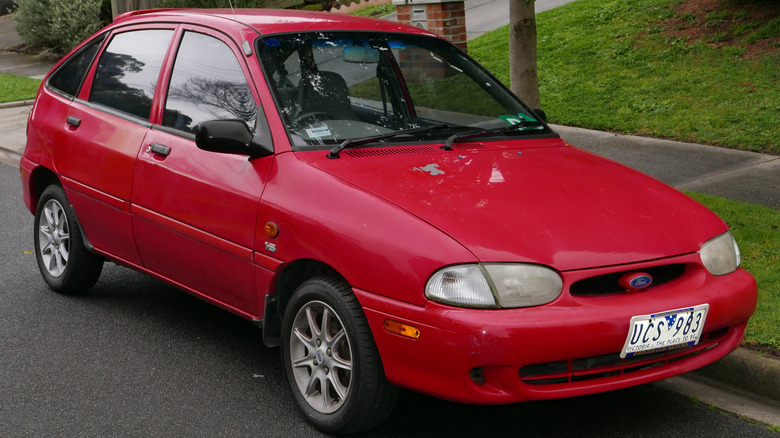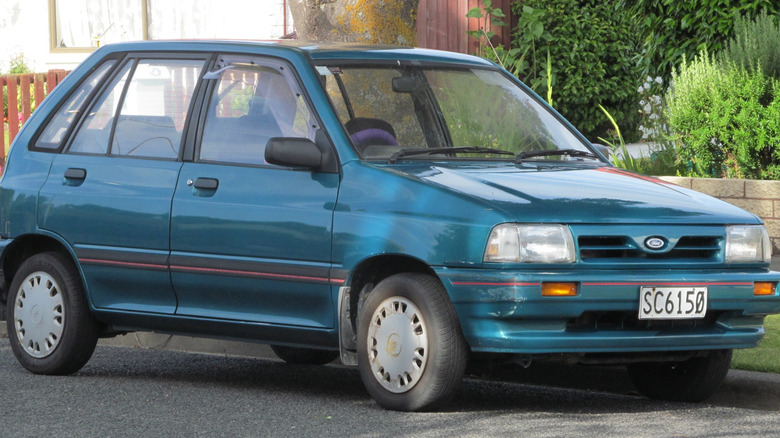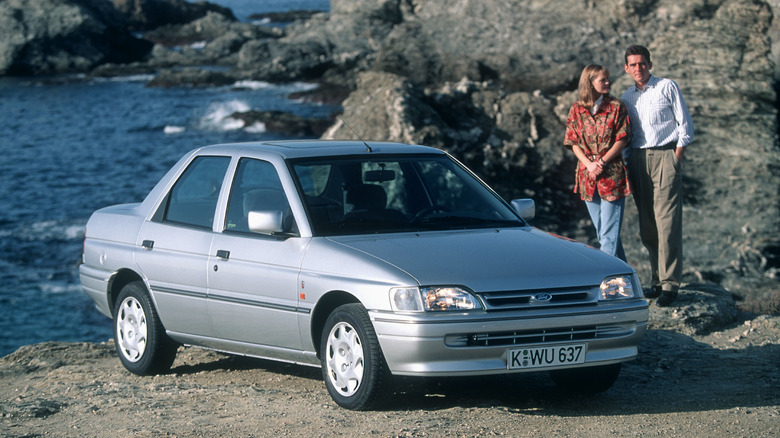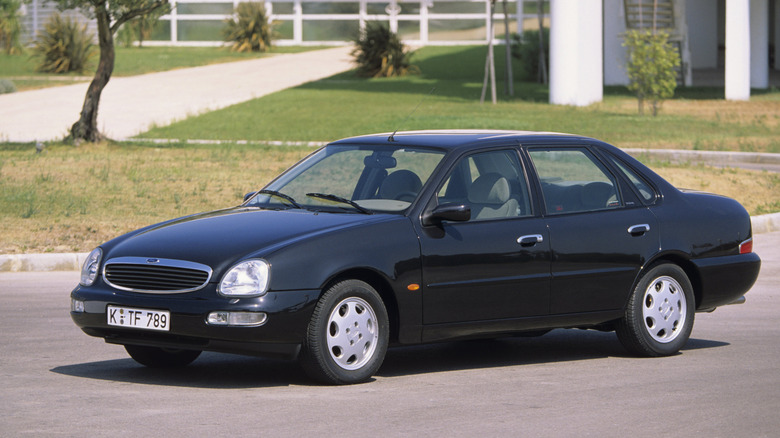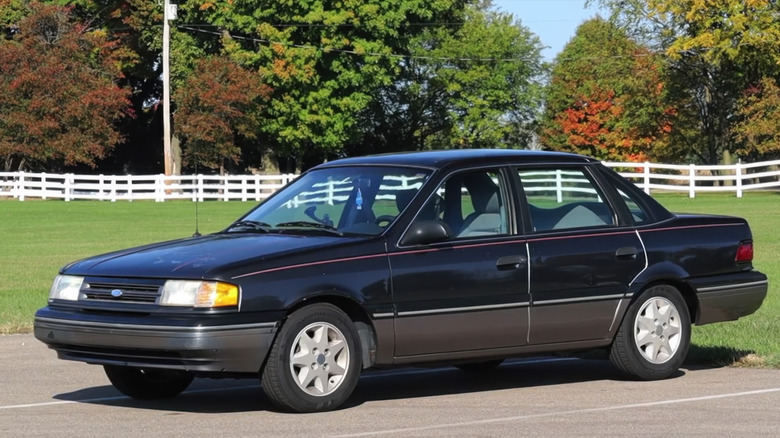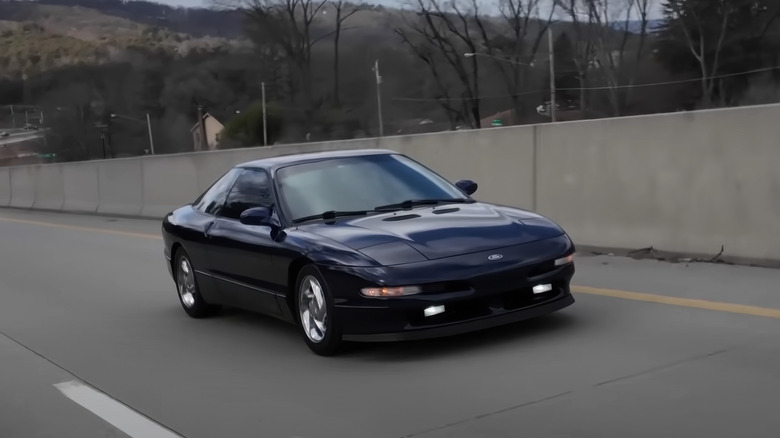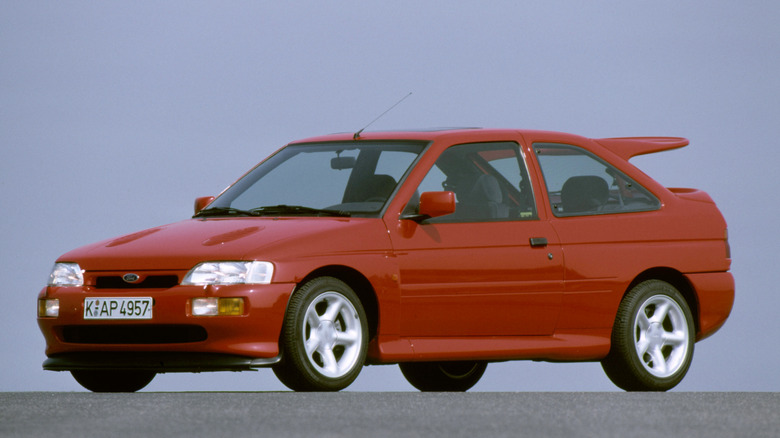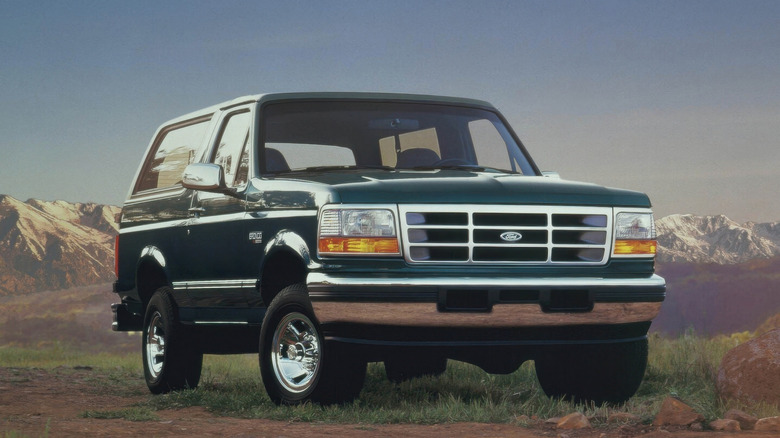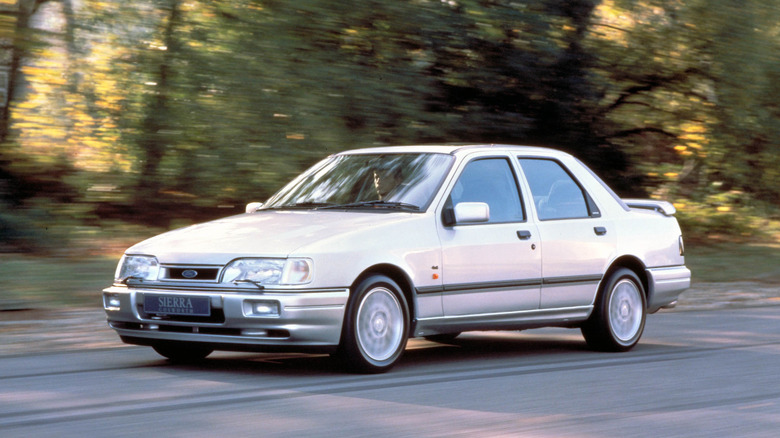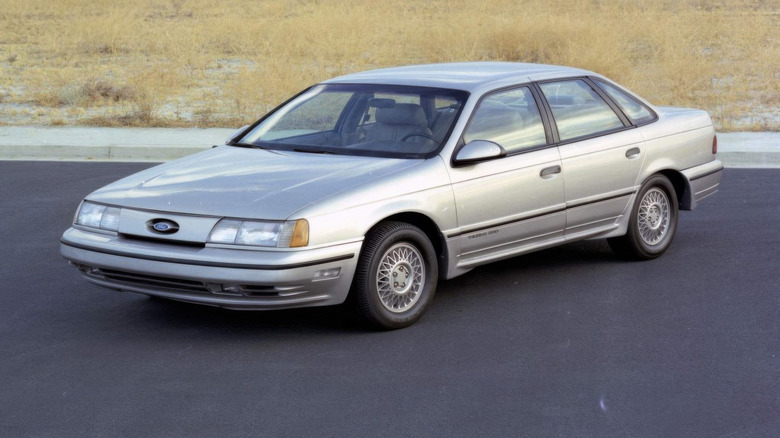12 Discontinued Ford Cars From The 90s, Ranked Worst To Best
Ford was a force to be reckoned with during the 1990s. Its F-Series pickup trucks were the best-selling in America. The Explorer marked a new family-SUV era for the company. The Mondeo showcased the brand's ability to design a groundbreaking car designed for most world markets. Across the pond, the Fiesta Mk3 conquered the Old Continent with advanced suspension and engines.
However, the 90s were also a turbulent period. In an effort to reach every possible category, the Blue Oval went the unpopular, badge-engineering route. Despite it's uber popularity, the Explorer was also part of one of the worst recalls, after its disintegrating Firestone tires led to rollovers. 271 people were killed. 823 were injured. The scandal was bad enough it ended the 100-year partnership between Ford and Firestone.
Some of Ford's models were ripe for replacements, too. Toyota and Honda were experiencing huge sales boosts during the 1990s, launching, new, more technologically advanced cars. This led to the disappearance of many Ford models. Some popular nameplates were revived later, but others had to be satisfied with a place in history books.
Ultimately, though, being a market failure doesn't always mean a car is necessarily bad. In fact, some of those models were excellent. So, let's have a closer look at 12 discontinued Ford cars from the 90s, and rank them from worst to best.
Ford Aspire (1993-1997)
The Aspire was Ford's second attempt at gaining traction in the subcompact hatchback category, after the Festiva failed to convince buyers. However, this wasn't really a Ford, but a badge-engineered Kia Avella, which itself was based on the aging Mazda 121. This may not sound like a bad combo from today's perspective, but 1990s Kia wasn't 2020s Kia.
The Aspire was also built in Korea and came with a 1.3-liter gas engine producing 63 hp. Five-speed manual was standard, while a three-speed automatic was optional. One of the main selling points was the dual airbags, though the Avella/Aspire weren't exactly safe. Hey, but the Aspire at least got 42 mph on the highway and was decently reliable!
Look, it's easy to make fun of a car that cost only $8,895 in 1997. We get it. However, the bigger and better Dodge Neon started at $9,475, and came with a way more powerful 132-hp engine. The Escort was also better at almost everything, for $1,600 more.
Not to mention, the Aspire had no connection to Ford's other models. Meanwhile, Europe got the superior Fiesta. A well thought out supermini, the Fiesta showed what Ford was truly capable of. It was good to drive. Well made. Practical. Maybe Ford North America should've called Ford Europe instead of Kia for this one.
Ford Festiva (1988-1993)
The Aspire's predecessor in North America was even more of an econobox. Small (140.5 inches long), with a Yugo-like profile and a 1.3-liter engine, the Festiva was the entry point in Ford's lineup. It was a carbon copy of the Mazda 121, though built in Korea, just like the Aspire.
Curiously, the 121 wasn't available in Japan. Instead, Japanese buyers could opt for the Festiva. Perhaps Mazda knew that the 121 wasn't good enough to be sold in its demanding home market? Meanwhile, the Kia Pride was the third car from the badge-engineering collaboration between Ford, Mazda, and Kia, which ended up being quite popular in Korea.
Ford also offered a sporty GT-X version in Japan with a 16-valve 1.3-liter engine that produced 87 hp and a five-speed manual. Unfortunately, North America only received the 63-hp tune. Weighing only 1,700 pounds, the Festiva was certainly not glacial. Still, it would've been nice if Americans got the 16-valve head, especially since the Festiva handled well.
Even that wouldn't have changed the fact that the Festiva was a cheap vehicle that was more expensive than its rivals. Yes, the Festiva carried the Ford badge, but it wasn't a real Ford. To add insult to injury, Ford only offered a three-door hatchback of the Festiva in the U.S. Meanwhile, buyers in other markets could opt for a four-door sedan or five-door hatchback.
Ford Orion Mk III (1990-1993)
The Orion was essentially the sedan version of the Escort, which Ford sold under a different name probably to boost sales. It was a fine compact sedan, but with a nameplate that limited sales, so Ford discontinued it after only three years. You could still get it following its demise, but it was then sold as the Escort Saloon.
Although an Escort through and through, the Orion wasn't available with the fun engines, like the 2.0-liter, 147-hp in the RS2000 model. Instead, buyers could choose between 1.3-liter, 1.4-liter, 1.6-liter, and 1.8-liter four-cylinder gas engines, ranging from 60 to 105 hp, all mated to a five-speed manual transmission. A slow 1.8-liter diesel was also available. It produced only 60 hp, but it also sipped fuel at 42-mpg combined.
Well, at least the engines were fairly reliable, though the same couldn't be said for the transmission. Also, early pre-1992 models had a harsh ride, and generally, the Escort became truly reliable after 1995. Sorry Orion Mk III, but that excludes you.
Ford Scorpio Mk II (1994-1998)
When the Scorpio Mk II started appearing on European streets, everyone wondered whether this was some past, classic Ford model. It looked old, but not in a good way. You could say it was out of fashion, but this staggeringly ugly body would've never been fashionable. The bug-eyed front was enough to make you melancholic, and the low and narrow taillights gave the car the appearance of a hump. Undoubtedly, the Ford Scorpio is easily one of the worst-looking Fords ever made.
It's funny, because the Scorpio Mk II was otherwise a very modern car underneath. Although it shared the platform with its sleeker predecessor, the Scorpio had a vastly improved suspension and higher torsional rigidity. So, although it looked slow, it handled much better than the predecessor. Ford even installed fluid-filled bushings in the rear to improve ride quality on the cavernous back seats.
With the right engine, the Scorpio could compete with the best the Germans had to offer. And by that, we mean the Cosworth-designed, 2.9-liter V6, which made 204 hp. A four-speed automatic sent the power to the rear wheels and was perhaps the reason for the slow 0-62 mph sprint of 9 seconds. Still, the Scorpio could reach 140 mph.
Smaller 2.0-liter and 2.3-liter four-cylinder engines were also available, alongside a 2.5-liter turbodiesel with 116 hp that was good for 28.3-mpg combined. Unfortunately, it wasn't enough; Ford discontinued the Scorpio after only four years on the market, selling just 98,587 units.
Ford Tempo second gen (1988-1994)
The first-gen Ford Tempo was far from the most interesting car in the 1980s, but at least it looked half good, and had a low drag coefficient of only 0.36 Cd. It even had a computer-designed interior, which, frankly, looks alright for the era. Still, the engines let the car down; the HSC four-cylinder units were reworked inline-sixes with roots in the 1960s.
The second-gen Ford Tempo might be even more meh. Sure, the body was streamlined, but Ford took away the soul of the car — it simply looked like most other cars from the era. The 2.3-liter HSC four-cylinder from the predecessor was the base engine, producing laughable 99 hp. A Honda Civic from the same era had 109 hp — from a 1.6-liter capacity!
So, what is a dull Ford car doing that high up this list? Well, from 1992 to 1995, it was also available with a 3.0-liter Vulcan V6 engine with 130 hp. Ford even stiffened the suspension and paired it with a five-speed manual. Was it a riot? Probably not, but certainly a sleeper. It reached 60 mph in 9.3 seconds — not bad for a mild performance car from the 1990s.
Still, it was ultimately not enough to attract buyers. The first-gen model actually proved extremely popular — Ford sold 531,468 units during the first year of production. However, the second-gen Tempo was discontinued after dwindling sales, but also to make space for Ford's first world car, the Ford Mondeo/Contour.
Ford Aerostar (1992-1997)
Ford doesn't currently sell a minivan, and it's never truly hacked the segment, but not for lack of trying. The Blue Oval launched the advanced Aerostar in 1986 to compete with Chrysler. This streamlined, aerodynamic minivan had a drag coefficient of just 0.37 Cd, and a spacious, practical interior. It was fuel-efficient, too, and it offered a more comfortable ride and better handling.
The Aerostar got even better in 1992, when Ford heavily reworked it to include things like a standard driver's airbag, bucket seats with shoulder belts for the second row, and a more modern dashboard design. By then, the engine options were also quite excellent. High-end models got a 4.0-liter V6 with 155 hp, but the Aerostar was also available with the 3.0-liter Vulcan, which made 145 hp. Ford offered a rare five-speed automatic transmission on latter models, alongside a five-speed manual. Heck, the Aerostar was even available with AWD from 1990.
Still, the Aerostar was also the only rear-wheel-drive minivan, which had some drawbacks, particularly for maximizing interior space. More importantly, though, it was a more expensive platform. As a result, sales were far from stellar. Thus, launched the front-wheel-drive Windstar in 1994, which was much better equipped to deal with the competition. The Aerostar continued for three more years, until Ford finally killed it in 1997.
Ford Contour (1995-2000)
The Contour was the North American version of Ford's first world car, the Mondeo. North America received its version two years later, but it was still a very competitive car. In fact, according to the press, it was too good to fail. Ford made significant advancements in terms of structural rigidity, making this FWD compact sedan one of the best driver's cars on the market. The automaker even paid attention to how engaging the Contour/Mondeo felt behind the wheel. Suffice it to say, it was lightyears ahead the Tempo it replaced.
The main attraction, though, was the underappreciated Ford Contour SVT sports sedan. Under the bonnet, the SVT hid a 2.5-liter V6 with some special performance parts. Larger throttle body. Hypereutectic pistons. Polished upper intake manifold. 2.25-inch stainless-steel exhaust system. The result: 195 hp. 0-60: 7.5 seconds. The short and precise five-speed manual only added to the experience. MotorTrend liked it quite a lot, saying it was good enough to satisfy your Mustang cravings.
Still, the Contour was too small for American buyers, particularly in the second row. More than that, though, it was expensive, leading to lackluster sales. Ford couldn't even sell the 5,000 Contour SVTs it planned. Ford did launch a larger Mondeo in 2001 in Europe. Still, it was never brought to America, because it would've competed directly with the Taurus.
Ford Probe (1989-1998)
The Contour SVT might've been a family-oriented Mustang, but it lacked one very important thing — a rear-wheel-drive chassis. In the 1980s, Ford didn't see the problem. In fact, it wanted to replace the Mustang with the front-wheel-drive Probe. We all know it didn't end well.
But it's not like the Probe wasn't attractive. On the outside, it looked way more modern than the fox-body Mustang. Sleeker. More dynamic. It was a more advanced car, too, with adjustable suspension, in place of Mustang's live rear axle. Ford did such a good job that the Probe was received more favorably by the media than its platform cousin, the Mazda MX-6. It was initially received well by the public, too.
Unfortunately, the Probe never came with a V8 engine. Still, the first-gen model came with a 2.2-liter turbocharged inline-four with 145 hp, enough for a 0-60 sprint of just 6.7 seconds. The sleeker second-gen Probe received a 2.5-liter V6 range topper with 164 hp, good for a 7.0-second sprint.
The first-gen and second-gen Probe differed in other ways, though neither could capture the Mustang's aura. The 1981-1982 economic downturn, which Ford though will end the Mustang, was forgotten in the 1990s. So, instead of improving the Probe once again, Ford moved its focus to what buyers really wanted — a next-gen Mustang. The FWD platform continued its life in the Mercury Cougar, but that car was also axed by 2002.
Ford Escort second/third generation (1990-2003)
The Escort was once to Ford what the Corolla was to Toyota — a small, fuel-efficient, and affordable bestseller. Still, it was initially developed by Ford Europe, with minuscule dimensions that would not have worked in America. So, while the Old Continent got a taste of Ford's small family car in 1968, North America waited until 1980. It proved quite popular, with Ford selling 440,000 units in 1984.
Escorts from Europe and North America were different, though. This was the most apparent during the 1990s, when the second-gen Escort arrived in North America. Available in four body styles — four door sedan, five-door station wagon, five-door hatchback, and a three-door hatchback, the American Escort also had an angular, sleek look. The three-door hatchback was also available with a Mazda-sourced 1.8-liter four-cylinder, good for 127 hp and a 0-60 sprint of 8.1 seconds. Car and Driver even said it was a worthy rival to the Golf GTI and Civic Si. Let's also not forget the European Escort RS Cosworth homologation special, which was a true beast with 224 hp and four-wheel drive.
Ford refreshed the Escort for another generation in 1996. It was bigger and better, and sold for the same price as the predecessor. Still, as time went by, the Escort started to lose its popularity. Ford was also working on something much better — the way more advanced Focus. So, by 2003, the last North American Escort rolled of the production lines. Interestingly, though, Ford revived the Escort for the Chinese market in 2018.
Ford Bronco fifth-gen (1992-1996)
Ford discontinued the Bronco in 1996, despite being reasonably popular during an era when SUVs were still seen as specialized vehicles. Many would say that the televised O.J. Simpson car chase led to the model's fallout, but according to Mark Schirmer, a communications manager for Ford utility vehicles, the two-door SUV category was already losing popularity. Instead, Ford focused on the four-door segment, which let the company flourish in the booming SUV market.
Still, the more benign reason for the Bronco's demise doesn't change the fact that Ford's cool-looking two-door SUV was an excellent vehicle. Equally at ease on the street and challenging terrains, the fifth-gen Bronco also brought some much-needed improvements, like a smoother, more aerodynamic body. It was even available with a 5.8-liter V8 that produced up to 203 hp.
However, Bronco's discontinuation wasn't received well by enthusiasts. The two-door SUV was a beloved vehicle in America, and cries to bring it back lasted for over two decades. Ford finally corrected its mistake in 2020 with a multi-pronged approach. A two-door Bronco was available, but also a four-door model and a car-based Bronco Sport. With the new Bronco, Ford went beyond nostalgia, creating an SUV that lit up the masses with an attractive design, real off-road chops, and potent engines.
Ford Sierra (1987-1993)
The Sierra arrived in 1982 to carve a new path for the Blue Oval in Europe. It was a challenging task, as it needed to replace the beloved Cortina, an underrated Ford model that deserves a spot in your garage. With its forward-thinking design, the Sierra quickly stole the limelight.
Crucially, the streamlined body allowed for a low drag coefficient of just 0.34 Cd, an impressive feat for the time. Ford further streamlined the styling in the refreshed 1987 Sierra, making it one of the most recognizable 1990s vehicles. But the Sierra had other aces up its sleeve, like a modern, wraparound dashboard, and a practical five-door hatchback model, alongside a traditional Sapphire sedan. The engines, borrowed from the Pinto, were a slight downside, but not enough to kill Sierra's market fortunes.
Still, we all remember the Sierra for the RS Cosworth and RS500 homologation specials. The more potent RS500 packed a 2.0-liter turbo-four that produced 221 hp, or up to 550 hp in race trim. It had a 4x4 drivetrain. Huge spoiler. Air vents all around the body. A true Ford legend we wish would've made it to the U.S.
Ford Taurus SHO (1989 to 1999)
The U.S. sometimes misses out on legendary cars, but Europeans would've also wished they had the Ford Taurus SHO (Super High Output). Frankly, this is the 1990s discontinued Ford car we most miss today. Yes, Ford relaunched it in 2010, but as a larger, heavier, 365-hp AWD sedan, which didn't exactly capture the original's aura.
Speaking of aura, how about a Yamaha-tuned 3.0-liter Vulcan V6 that produced 220 hp and 200 lb-ft of torque, and revved to 7,000 rpm? Even better, it came with a slick-shifting five-speed manual, performance dampers and springs, and thicker anti-roll bars. 0-60 mph: 6.6 seconds. Top speed: 143 mph. As good as it gets for a 1990s front-wheel-drive performance sedan.
But Ford wasn't going to rest on its laurels, and in 1993 started equipping the Taurus SHO with a larger 3.2-liter with the same horsepower figure, but a higher 235 lb-ft of torque. A four-speed automatic was also available, but of course, the manual suited this car better. Then, in 1996, Ford even crammed a Yamaha-tuned 3.4-liter V8 in the Taurus SHO, which was good for 235 hp. Unfortunately, it only came with the four-speed auto.
How did we rank these models?
Naturally, the main ranking parameter is how these models fared against their rivals during the 1990s. Also, how well they were received by the media, and how we view them today. Time can change a perspective on cars, and for some of these, that has had a significant effect on the position. Market success also played a role, though, as you learned, most of these cars weren't exactly thriving.
